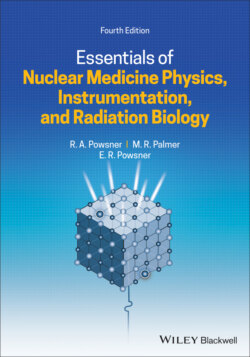Читать книгу Essentials of Nuclear Medicine Physics, Instrumentation, and Radiation Biology - Rachel A. Powsner - Страница 22
Nucleus
ОглавлениеLike the atom itself, the atomic nucleus also has an inner structure (Figure 1.8). Experiments showed that the nucleus consists of two types of particles: protons, which carry a positive charge, and neutrons, which carry no charge. The general term for protons and neutrons is nucleons. The nucleons have a much greater mass than electrons. Table 1.1 reviews the properties of the various subatomic particles.
A simple but useful model of the nucleus is a tightly bound cluster of protons and neutrons. Protons naturally repel each other since they are positively charged; however, there is a powerful binding force called the nuclear force that holds the nucleons together very tightly (Figure 1.9). The work (energy) required to overcome the nuclear force, the work to remove a nucleon from the nucleus, is called the nuclear binding energy. Typical binding energies are in the range of 2 million to 9 million electron volts (MeV) (approximately one thousand to one million times the electron binding force). The magnitude of the binding energy is related to another fact of nature: the measured mass of a nucleus is always less than the mass expected from the sum of the masses of its neutrons and protons. The “missing” mass is called the mass defect, the energy equivalent of which is equal to the nuclear binding energy. This interchangeability of mass and energy was immortalized in Einstein’s equation E = mc2.
Figure 1.8 The nucleus of an atom is composed of protons and neutrons.
Table 1.1 Properties of the subatomic particles
| Name(s) | Symbol | Mass a | Charge |
|---|---|---|---|
| Neutron | N | 1839 | None |
| Proton | P | 1836 | Positive (+) |
| Electron | e– | 1 | Negative (–) |
| Beta particle (beta minus particle, electron)b | Β– | 1 | Negative (–) |
| Positron (beta plus particle, positive electron) | β+ | 1 | Positive (+) |
| Gamma ray (photon) | γ | None | None |
| X‐ray | X‐ray | None | None |
| Neutrino | ν | Near zero | None |
| Antineutrino | Near zero | None |
a Relative to an electron.
b There is no physical difference between a beta particle and an electron; the term beta particle is applied to an electron that is emitted from a radioactive nucleus. The symbol β without a minus or plus sign attached always refers to a beta minus particle or electron.
Figure 1.9 Nuclear binding force is strong enough to overcome the electrical repulsion between the positively charged protons.
